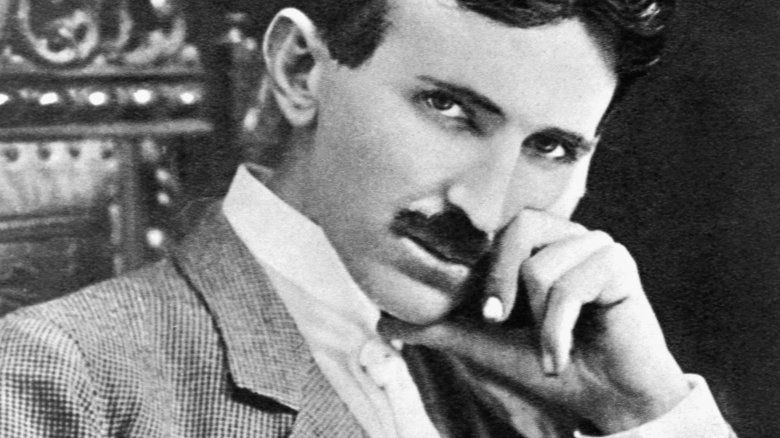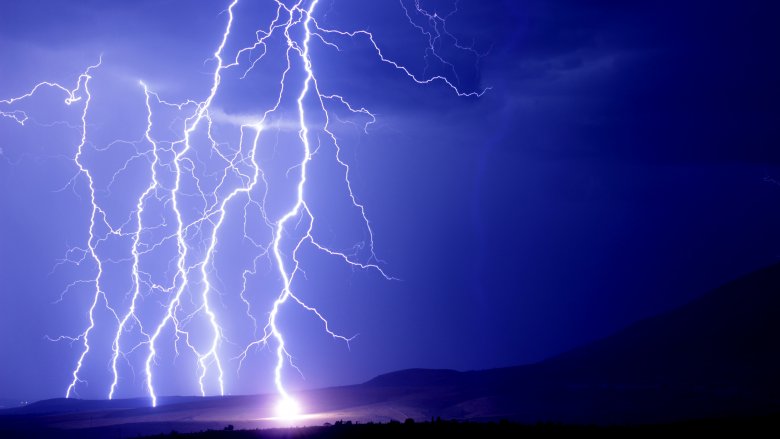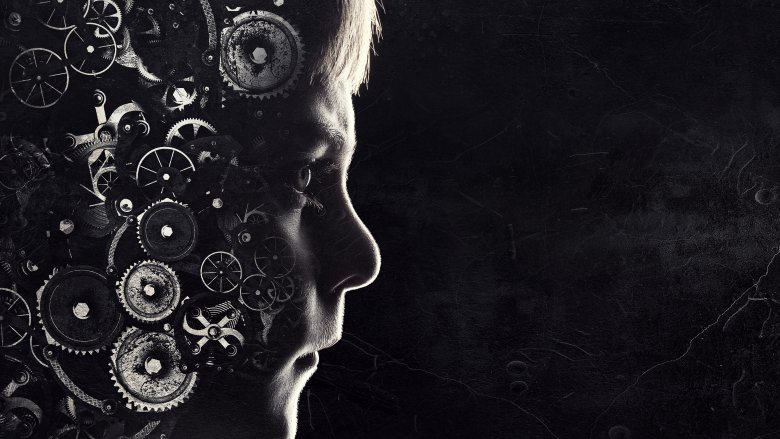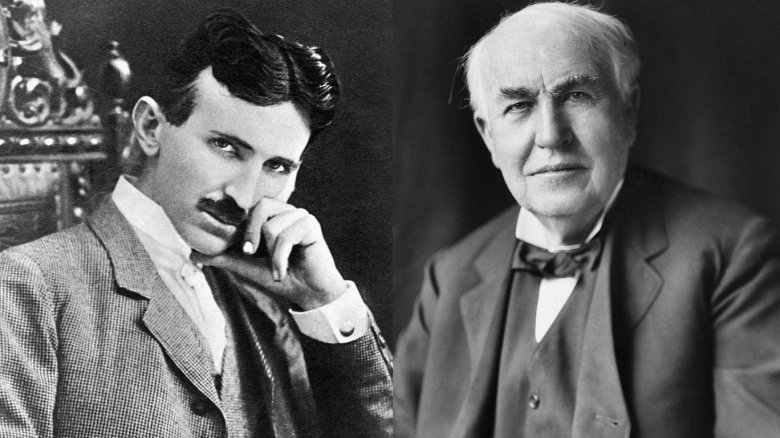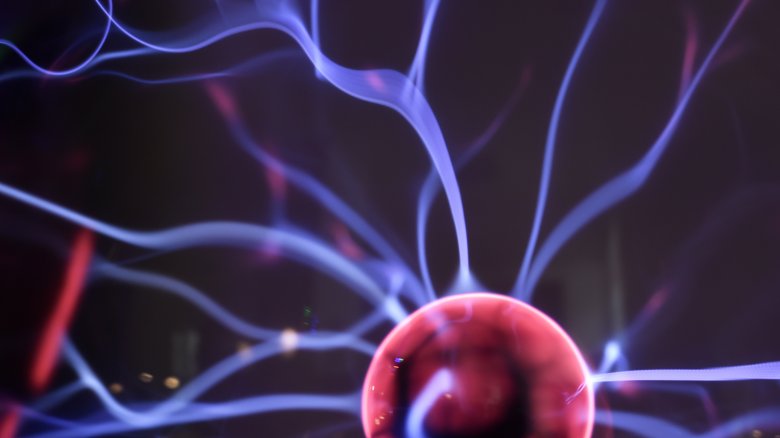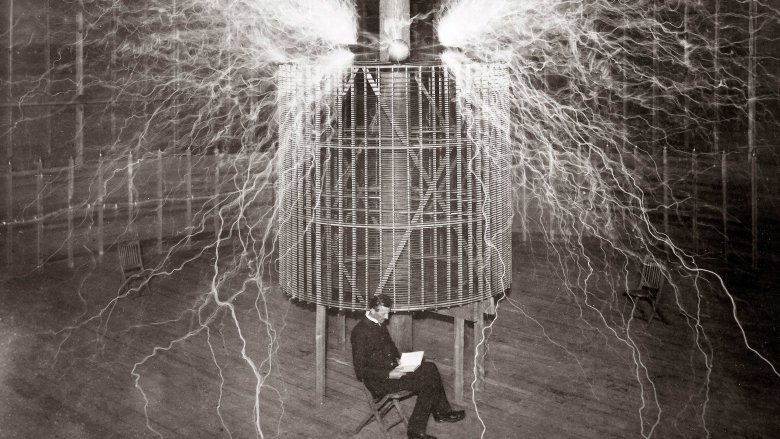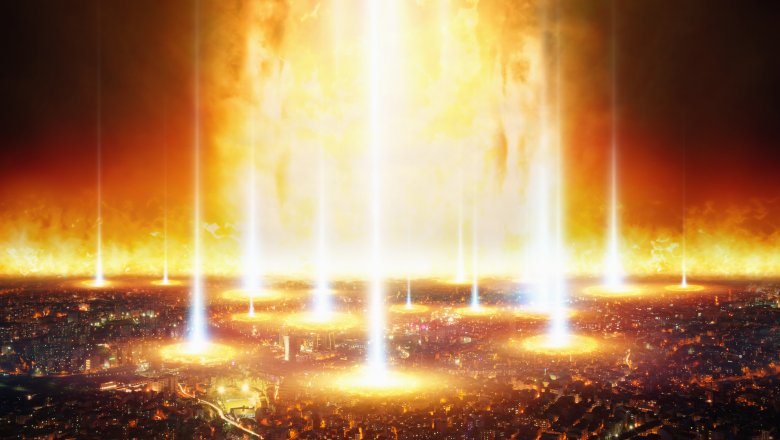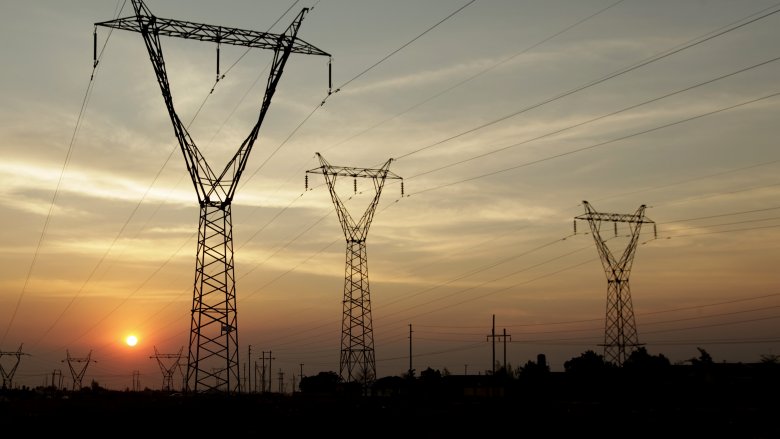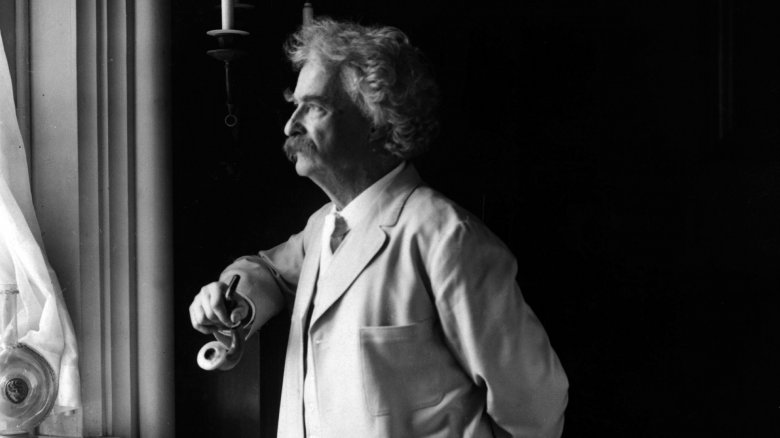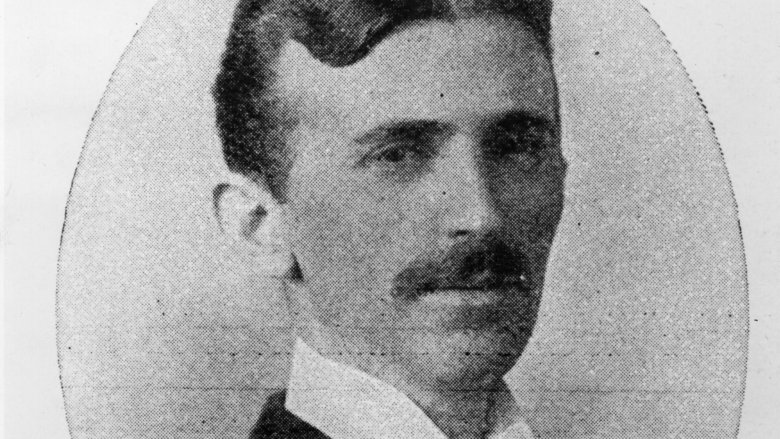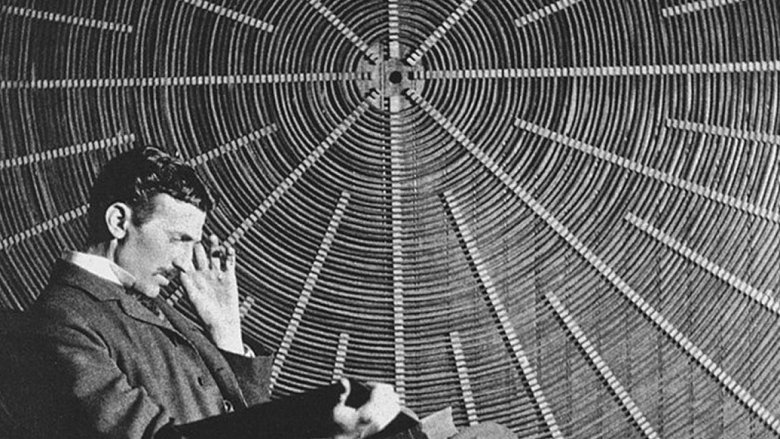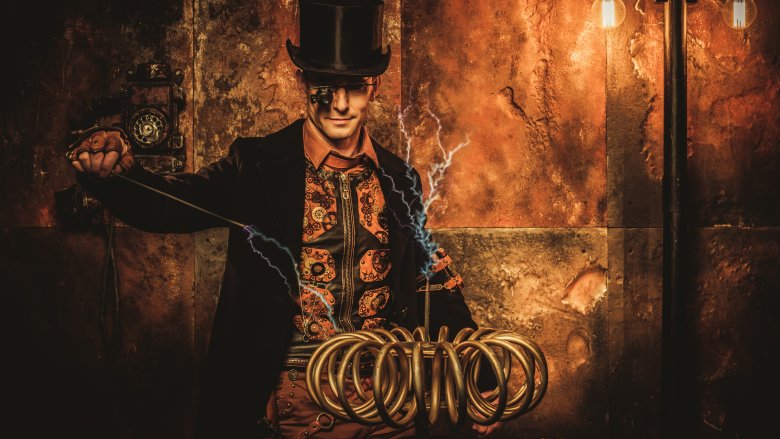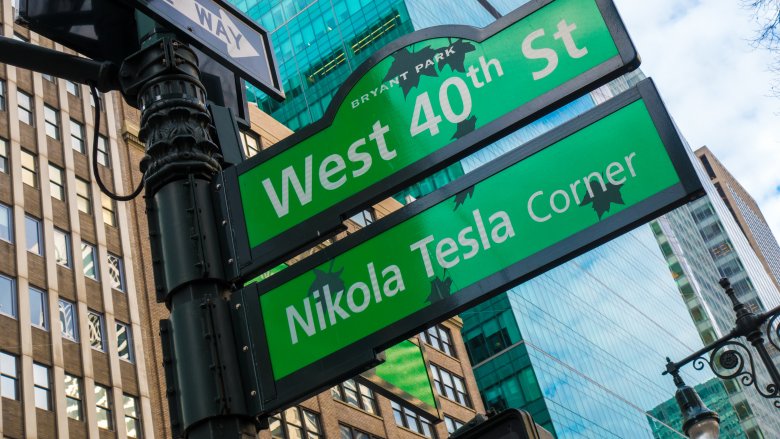Nikola Tesla's Unbelievable Real-Life Story
Any list of genius inventors in history would be incomplete without Nikola Tesla at the top of it. Tesla wasn't just brilliant: His inventions changed the world in ways that are still visible every single day. However, despite possessing both mesmerizing intelligence and an altruistic heart, Tesla suffered a difficult life, which only became more tragic in his later years. It all began on a dark and stormy night...
Tesla was born during a lightning storm (maybe)
If Nikola Tesla were a superhero, his moniker would be "Electricity Man." Sure, Benjamin Franklin might've gotten zapped through his kite, but Tesla completely revolutionized the entire field of electricity technology, making science fiction into science fact.
Though Tesla was larger than life, the popular legend about how (and when) he was born might be a little too cinematic to be true. According to Hourly History's Nikola Tesla: A Life From Beginning to End, the story goes that Tesla entered the world in 1856, in what is now Croatia, in the midst of a horrific lightning storm. Yes, that's right, the Electricity Man was supposedly born during a lightning storm. Reportedly, the storm was so bad that the midwife got the willies and told Tesla's mother that because of the nasty weather, the baby would be a "child of darkness." Luckily, Nikola's mother had no room in her life for that sort of morbid nonsense and promptly told the midwife, "No, he will be a child of light." Boom. See, isn't that the perfect superhero origin story?
It's hard to say if this exchange is a true story of a fun myth, but if Tim Burton ever directs a movie about Tesla's life, we expect to see this scene right at the beginning regardless.
His mother spurred him onto science
Whether Nikola Tesla rocketed to earth on a lightning bolt or not, we do know that his remarkable brain started diving into science from an early age. As a boy, according to Biography, young Nikola was torn in two directions. His father was a Serbian Orthodox priest who wanted his son to follow in his religious footsteps, while his mother was an inventor who liked tinkering with household appliances. Once the woman introduced science to her son, the boy's future was clear. Considering the impact Nikola's work went on to have, the world probably owes his mom a big thank-you for getting him started.
Anyway, Nikola loved studying science, and his schooling and research took him to Austria, Prague, and Budapest, where he ended up working for the Central Telephone Exchange. It was in Budapest where, one day on a leisurely walk through the park, he randomly came up with the idea for what would one day be the induction motor, one of his greatest inventions. However, Tesla didn't stay in Budapest for too long. He dreamed of setting sail for the United States, and at age 28, he finally did so. Not long after landing on America's rocky shores, he met a man named Thomas Edison.
He worked with Thomas Edison
If there were ever two inventors fated to be antagonists, it was Nikola Tesla and Thomas Edison. Tesla possessed an intense, aloof, introverted personality, while Edison was a loud, boisterous businessman. According to the Tesla Memorial Society of New York, Tesla's immigration happened because of a recommendation letter that inventor Charles Batchelor wrote to Edison, stating, "I know two great men. One is you, and the other is this young man."
Inspired by their common fascination in electricity, Tesla journeyed to the U.S. with nothing but the clothes on his back, and a head buzzing with new ideas. He promptly went to work for Edison. At the time, Edison's company was using "direct current" electricity, and the newbie Tesla proposed an innovative idea: replacing the inefficient direct current setup with what Tesla called "alternating current." Edison scoffed at this, challenging Tesla to develop his ideas into a real invention. As incentive, Edison even offered the broke young European inventor a $50,000 reward, according to History.
So, Tesla gleefully pounced on the challenge, and within only a few months, he proudly offered Edison his successful results. One problem: Edison was a huge jerk about the whole thing, and he brushed Tesla off with a mean comment about how Tesla didn't understand "American humor." You can't blame Tesla for leaving Edison's company shortly afterward.
Tesla was right about electricity
Here's the catch: Tesla was right, and Edison was wrong. Basically, the problem with Edison's direct current (DC) electricity setup was that it only flowed in one direction. Meanwhile, Tesla's groovy new alternating current (AC) changed direction 50 to 60 times a second, according to the Tesla Memorial Society of New York. Why did this matter? There are a lot of technical reasons, but basically, in addition to having inefficient lamps, Edison's setup required power stations to be built every 2 miles, making it a huge chore (and financial burden) to send power a long distance. Tesla's AC idea changed that.
After Edison stiffed Tesla his $50,000, Tesla responded by getting funding from George Westinghouse. Westinghouse saw the potential in AC, and decided to spread Tesla's invention across the country, powering the entire United States. The business war between Edison and Westinghouse/Tesla got pretty intense, but Tesla's technology won out because AC just ... worked better. Nothing personal.
Tesla's most notable victory came in 1896, when his AC invention harnessed the power of Niagara Falls, sending electricity all the way to Buffalo, New York. Using Niagara Falls as a power supply was a major achievement in its own right, but according to PBS, and it was also one of Tesla's childhood dreams.
The wizard of inventions
Tesla crafted amazing new inventions at the same rate that some people change their socks. In addition to pioneering the use of AC, he also created the "Tesla coil," which would go on to become the basis of radio and TV today, according to Business Insider. History points out that he played around with X-rays, invented electric oscillators and meters, and worked with radio communications. As if that wasn't zany enough, Tesla then designed a remote-controlled boat, also described by History, which he hoped would forever end the use of battleships. He figured if he could create a warship that required no humans on board, it would mean less lives lost. Today, remote-controlled boats are mostly just a hobby.
One of Tesla's most infamous inventions was his supposed "earthquake machine," which he talked about to the New York World-Telegram in 1935, according to Rex Research. Tesla claimed his device could fit "in an overcoat pocket," and that he'd once triggered such a heavy earthquake in New York City that the police had rushed to his lab. Crazy, right? Mythbusters tried (and failed) to replicate his experiment, so who knows if the "earthquake machine" really worked.
All the inventions he didn't finish
The only thing more impressive than Tesla's inventions are the ones he dreamed up, but never completed. In an effort to end all wars, Tesla at one point developed plans for a "death beam," according to PBS, which he claimed would "send concentrated beams of particles through the free air, of such tremendous energy that they will bring down a fleet of 10,000 enemy airplanes at a distance of 250 miles." Tesla's idea was to develop a weapon so insanely powerful that it would deter any countries from ever invading each other again.
Tesla's otherworldly concepts hardly ended there. According to The Week, he envisioned a future wherein all labor would be automated. Factories would be run by robots, and cars would drive themselves. Yes, Tesla predicted the self-driving car back when the whole concept of "cars" was still fresher than a spring chicken.
Tesla's strangest claim of all came in 1901, when he said he'd received radio transmissions from Mars, as described in The Electrical Age. (If anyone ever did discover Martians, it would've been Tesla.) However, History says that in 1996, scientists replicated Tesla's experiments and found that the signals were just caused by the moon Io passing through Jupiter's magnetic field. Still, Tesla gave it his best shot.
He believed in a world of free electricity
Believe it or not, none of this stuff even touches the scope of Tesla's most ambitious project of all: he wanted to bring free wireless electricity to everyone in the world, according to Biography. In 1901, J.P. Morgan funded Tesla's dream of building a giant transmission tower on Long Island, which the inventor named Wardenclyffe. As unbelievably awesome as free, worldwide, wireless electricity sounds, the Wardenclyffe project hit a tragic stumbling block when Tesla's investors second-guessed whether he could actually pull it off. Keep in mind, back in 1901, the internet wasn't even a twinkle in anyone's eye, so the idea of free worldwide electricity seemed like something from a fairy tale.
Anyway, once the foundation was shaken, the project collapsed. First the staff got laid off in 1906, then the tower itself was foreclosed in 1915, and Tesla went into bankruptcy by 1917. As a result, Tesla's dream of bringing us free electricity never happened. The worst part about all this is that there's probably a parallel universe somewhere where Wardenclyffe did succeed, and those lucky alternate versions of us are enjoying the benefits of $0 utility bills to this day. Too bad Tesla didn't figure out a reality-switching invention.
He and Mark Twain were good friends
Nikola Tesla wasn't known for having many friends, close associates, or even romantic partners. According to EDN, the man was so devoted to his science that he remained celibate throughout his life, believing love and marriage would interfere with his work.
However, Tesla did have one good friend you've probably heard of: Mark Twain, the author of Tom Sawyer and Huckleberry Finn. Twain, whose real name was Samuel Clemens, was close enough to Tesla that, according to the book Nikola Tesla: A Spark of Genius, the legendary writer was given a free pass to visit the legendary inventor's laboratory whenever he pleased. As described in James O'Neill's Prodigal Genius: The Life of Nikola Tesla, Clemens once was the victim of a rather brilliant Tesla prank, wherein the inventor asked Clemens if he wanted to test out his new vibrating mechanical oscillator device. To convince him to do so, Tesla claimed that Clemens would feel renewed "vigor and vitality" from the machine. Instead, the heavy vibrations caused Clemens to have a bowel spasm, and the author had to sprint to the nearest bathroom.
Despite the shock of this event, the two remained friends. It's a historical buddy comedy waiting to happen.
Throughout his life, Tesla lived with mental illness
Nikola Tesla experienced mental illness throughout his life, and he lived in an era where such things were not properly understood or discussed. According to History, the first signs of this manifested early in Tesla's childhood, when he claimed to see "visions" after the death of his brother Daniel. From that point on, Tesla's symptoms only become more prevalent as he aged. Tesla was intensely careful about avoiding germs. He washing his hands constantly, always using fresh towels, and avoided handshakes at all costs, according to O'Neill's Prodigal Genius. He strove to sleep only two hours a night, believing three was too much time wasted. Between these traits and his obsession with the number three — he reportedly always walked around a building three times before entering it, washed his hands three times in a row, and so on — it's often been theorized that Tesla may have had obsessive-compulsive disorder, according to the Huffington Post.
The Smithsonian raises the possibility that he also may have been on the autism spectrum, citing his self-described intense sensitivity to sounds, his excellent sensory awareness, and his violent dislike for both pearls and women's earrings, the mere sight of which were enough to, in his words, "almost give me a fit."
He lived a difficult life
Aside from his mental illness, Tesla's life was extremely difficult in many respects. Perhaps most significantly, the great inventor was usually broke, down on his luck, and badly in debt. According to History, Tesla at one point worked a manual labor job where he dug ditches for $2 a day. In his later years, his introverted tendencies grew into an intensely reclusive nature. After the financial collapse of Tesla's beloved Wardenclyffe project, the brilliant man withdrew further and further into mental illness, becoming a hermit. His final years were spent living on the 33rd floor of the New Yorker Hotel, his primary companion being the pigeons who visited him there. Tesla reportedly spoke to these pigeons, becoming particularly close to one female pigeon whom he claimed to love as if she were a human being.
According to the Smithsonian, one of Tesla's final reports described this female pigeon visiting him at his hotel window one night, apparently to inform the inventor that she was dying. Tesla claimed to see glowing light in the bird's eyes, brighter than his own lightbulbs, and he allowed his beloved avian friend to die in his arms. According to Tesla, this strange incident was a sign that he had completed his life's work and was ready to move on.
He once paid an overdue bill with a 'death beam'
In an interview with National Geographic, Tesla Science Center president Jane Alcorn explained that Tesla had such frequent money problems because, unlike his rival Thomas Edison, Tesla didn't care about making money. Tesla's goal was to help the world, as exhibited by his grand worldwide electricity ambitions. However, like any other member of society, Tesla still had to pay the bills, and his cash woes led to some creative solutions.
In what might be the best practical joke of all time, Tesla once paid for an overdue hotel bill by giving the managers a little wooden box which he said contained a working model of his infamous "death beam," according to History. Yeah, you read that right. No cash, no credit card, just a little box with an apocalyptic weapon of mass destruction inside it. To sweeten the deal, Tesla warned the managers to never, ever, ever open the box, for their own safety. The fearful managers heeded his warning because no one wants to set off a death beam, but when the box was finally opened years later, after Tesla's death, the only thing inside it was a bunch of scrappy old electrical components. Nice one, Nikola.
Death and resurgence
Like so many of history's greatest mavericks, Nikola Tesla never truly received the respect he deserved. By the time he died in his hotel room in 1943, he was seen as more of a bizarre science fiction spectacle than a brilliant icon, a perception which the Smithsonian argues may have been created by Tesla's "willingness to play the mad scientist," by making wild claims in tabloid magazines. According to a New York Times piece from 1984, it wasn't until nearly 40 years after Tesla's death that society began to acknowledge the sheer magnitude of his impact on the world, and to realize how great his contributions truly were.
In the past few decades, public perception of Tesla has been coming around. According to National Geographic, a brand new Tesla statue was unveiled on Long Island in 2013. The Wardenclyffe site has been converted into the Tesla Science Center. The airport in Belgrade, Serbia, proudly displays Nikola Tesla's name. And of course, there's Elon Musk's famous Tesla company, which follows Nikola's path by developing new technologies for the future. Though Nikola Tesla struggled throughout his life, the history books will look back on him fondly.
